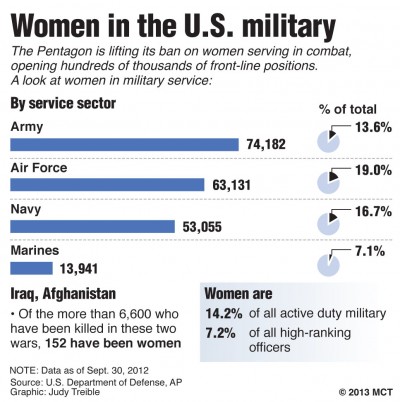
By MAVERICK FREEDLANDER
Sports Editor
In the United States of America, women have never been allowed to serve in the military with full combat roles. In order to progressively enhance equality in the armed forces, Secretary of Defense Ashton Carter said at a news conference December 3 that he will be allowing women to enter these full combat roles.
This is an extremely complicated issue; on the surface, it seems only right that women should be allowed to fight on the front lines with their male counterparts. When one delves deeper into the issue, though, some negative implications of women’s service in universal combat roles are revealed, and there is a question as to whether the value of instilling equality in the military outweighs the negative effects. A major issue which has been raised is the longevity and medical repercussions involved in full combat work for women. In the Marine Corps Gazette, Captain Katie Petronio questioned, “can women endure the physical and physiological rigors of sustained combat operations, and are we willing to accept the attrition and medical issues that go along with integration?” Petronio used herself as an example of this physical toll, saying “”at the end of the seven-month deployment, and the construction of 18 [patrol bases] later, I had lost 17 pounds and was diagnosed with polycystic ovarian syndrome (which personally resulted in infertility, but is not a genetic trend in my family), which was brought on by the chemical and physical changes endured during deployment.”
Considering who Captain Petronio is, and taking into account her previous stardom as an ice hockey player at the collegiate level, the results seem to suggest that the female body is not meant to endure a certain level of strain which can be reached while serving in a full combat role in the military. Sadly, Petronio’s case revealed a great deal about the long-term effects of full combat roles on women.
Martin Chinn (English Dept.) has a similar take on the case, pointing to the physiological differences between men and women as an important factor when considering gender integration in the military. He explained that “in the military, I saw women stronger than me and there were definitely some studs that were women. As a whole, though, the men were clearly more fit and capable than the women in terms of physical ability.”
Few argue the clear genetic difference between a male’s physique and a female’s. Chinn said, “I remember how much it bothered me when I had to carry someone else’s load or if a member of the team held us back, male or female. A light load when I was in the infantry was roughly 70 pounds, sometimes more. That 70 pound load is much different to a 110 pound female compared to a 220 pound man.” The job of being an infantryman entails certain characteristics that men possess more often than women as a result of pure genetics. Another issue that Chinn brought up is standards. “Standards for women in the military have historically been lower than men’s, partially due to the difference in their roles in the military. If women and men are going to both serve on the front lines, we should make the standards the same for both men and women,” said Chinn.
The military’s goal is not to give everyone a chance. The military’s goal is to protect us and to carry out our government’s agenda overseas in the most efficient way possible. If including women with lower physical standards hinders the military’s efficiency and effectiveness, it is not worth it. It is hard to fathom how lower standards could possibly result in anything but lower quality soldiers. There are many fights for equality that should be fought, but this is not one, for logical reasons. Men and women are simply built differently. Women, on average, are not as strong or durable as men. Also, women have more medical complications that can arise from physical deterioration, as is shown in Petronio’s case. Serving in the infantry is a demanding position, and while certain women absolutely can handle it, it seems that the female body is, more often than not, not cut out for that sort of physical strain.
Women on the front lines: gender roles and combat roles
January 19, 2016

According to the U.S. Department of Defense, women have served notable roles in the U.S. armed forces since as early as 2013. (TNS)
0
Donate to Sword & Shield
$180
$1000
Contributed
Our Goal
Your donation will support the student journalists of University High School. Your contribution will allow us to purchase equipment and cover our annual website hosting costs.
More to Discover













